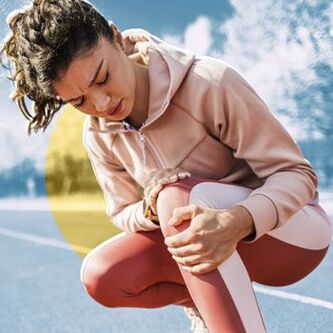
The main purpose of the knee joint is to ensure normal motor activity of the lower limbs and achieve a stable position of the trunk. In this case, this part of the body is assigned the most important role - participation in the processes of bending and extension of the limb.
Despite the complex structure and sufficient strength of this joint, it is subject to injuries, thermal effects, physical overload, various complications due to chronic infectious processes and, as a result, the processesSevere inflammation increases the likelihood of limited movement and accumulation. of secretions. To prevent such unwanted manifestations, a qualified specialist should be promptly contacted for a thorough diagnosis and appropriate treatment plan.
The knee is the most complex and largest joint in the human body.
Every day, a serious load is placed on the knee joint. It is responsible for the process of flexion and extension of the lower limbs, supporting a person's weight and ensuring his stable posture. Knees allow us to walk, jump, run, squat, and turn.
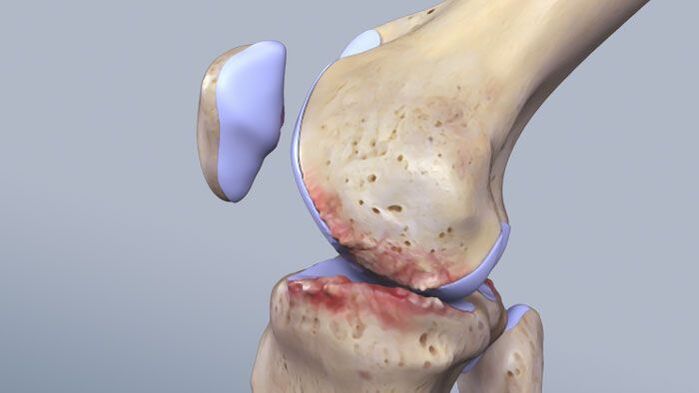
The ability to perform these actions is ensured by the following components:
- Close;
- Bone;
- Cartilage;
- Ligaments and muscles.
This explains why knee pain can occur at any age. We can talk about effective treatment and full recovery only after finding the cause of the disease.
Causes of knee pain
Therefore, the knee joint has an important role in the human body: it is responsible for controlling the movement of the legs, keeping the body in a stable position and supporting the human weight. Furthermore, the knee has a complex structure, represented by many interconnected elements.
If a person has knee pain and is looking for a solution, what to do is to first find out the cause of the discomfort. As a rule, the cause of the disease is the same in all situations.
The risk factors are the same in most cases: myofascial dysfunction. This results in significant tension, causing compression and destruction of the cartilage. As a result, a person begins to experience unpleasant sensations that signal damage to the knee joint and begins to look for ways to eliminate the pathological process.
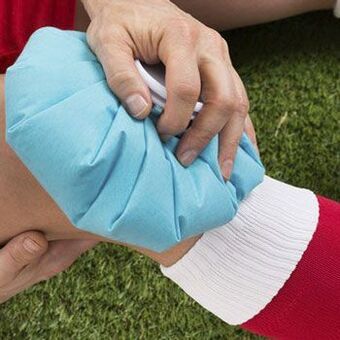
Injury
If you don't know what to do when your knee hurts, pay attention - the cause may be hidden in a joint injury. This is a part of the body that is more vulnerable than other parts. As a result, joint dysfunction occurs, accompanied by pain.
Such discomfort may be due to ligament damage. Representatives of professional sports activities are most often susceptible to injuries. Additionally, pain and ligament problems can occur in people who do not follow running technique. Most often, knee damage occurs from being hit by a ball - during a soccer match.
It should be noted that such injuries occur quite often. Moreover, unpleasant sensations can occur not only during an exacerbation, but also after it.
In the case of a fracture, many bones can be destroyed at once. More often than others, this occurs in elderly patients and those susceptible to degenerative pathologies.
In cases of severe joint damage, surgery, physiotherapy and exercise therapy are performed.
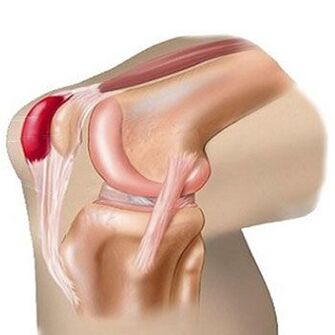
Bursitis
The main purpose of the joint capsule is to ensure that the ligaments slide easily and improve the function of the knee joint. Chronic injuries and sudden blows can cause damage and inflammation.
The presence of bursitis is indicated by the following signs: swelling, pain, limitation of motor activity, increased temperature in the knee joint.
If your knees hurt badly, to understand what to do and how to treat this disease, you should first conduct a thorough diagnosis. Only an individual approach to the problem will allow you to draw up the correct treatment plan and choose effective drugs with anti-inflammatory effect. You should also follow a rest regimen for your knee joints.
In advanced forms of bursitis, more serious measures are used - surgical intervention and special injections are performed.
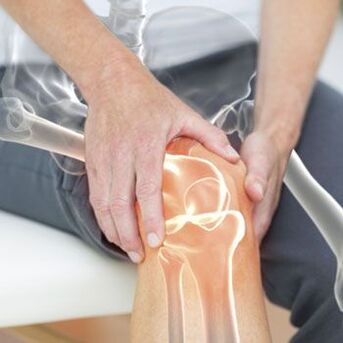
Dislocation
We are talking about displacement of the kneecap from its normal position, accompanied by pain of increasing intensity.
In this case, only an experienced specialist can answer the question of what to do if there is pain below the knee - after a thorough diagnosis and examination.
To identify fractures and come up with an accurate treatment plan, they resort to X-ray examination. In advanced situations, surgical intervention is performed.
Often a dislocated knee can cause pain. This is a fairly serious injury that occurs after a strong impact.
Degenerative disorders
One of the common pathologies associated with degenerative changes in tissues is osteoarthritis. In this case, the cartilage decreases in size, which is accompanied by impaired joint mobility and pain. As a rule, such pathological processes are caused by age-related changes in the body that occur in people aged 55-65 years.
Despite the irreversible degenerative changes, there are treatments that can cope with discomfort and help improve quality of life. In advanced forms of the disease, implants are installed surgically.
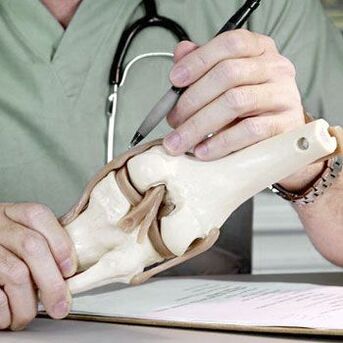
Autoimmune disease
We are talking about inflammatory processes that affect the joints. They are characterized by a malfunction of the immune system, due to which it begins to perceive its own tissues as foreign objects and destroy them.
This process leads to the following undesirable manifestations: swelling, pain, joint degeneration, and erosive damage to bone tissue.
Based on the clinical picture, the specialist will tell you exactly what you need to do when your knee hurts. As a rule, patients are advised to take the following drugs:
- Anti-inflammatory drugs;
- Steroid hormones;
- Antirheumatic drugs and biological agents;
- Painkillers and others.
Salt deposition in joints
This is a metabolic disease associated with the deposition of uric acid salts in the body's tissues. The main signs of gout are: severe swelling, limited physical activity and severe pain. To break down urate crystals, special medications as well as anti-inflammatory drugs are prescribed.
Infectious process
Even a small scratch in the knee area can contribute to the spread of infection to neighboring tissues and organs, including the joint area.
In people with weak immune systems, this poses a real danger to the body. That is, any damage to the skin can worsen the patient's condition.
What not to do when your knees hurt?
Regardless of the reason for your knee pain, below we'll tell you what not to do to avoid making the condition worse:

- Avoid knee injuries;
- Avoid foods that contribute to weight gain (fried, fatty foods, candy, salty foods, potatoes, sweet carbonated drinks, fast food);
- Avoid any excessive physical activity related to sports;
- If your knees hurt and you don't know what to do with the discomfort, as the reviews indicate, it is better to give up addictions (drinking too much alcoholic beverages and smoking cigarettes);
- Avoid wearing tight shoes, avoid high heels;
- Minimize the possibility of stressful situations;
- Ensure good health and adequate sleep;
- Avoid staying in one position for a long time.
In what cases do you need to see a doctor?
Medical intervention is not required if pain in the knee area is caused by minor skin damage, minor trauma, or joint deformity. In such situations, self-treatment is allowed.
With more serious procedures, there is an urgent need to see a specialist. First of all, this is due to the possibility of damage to the joint capsule, creating conditions for pathogenic bacteria to enter the body.
If the consequences of the injury are not removed in time, the function of the joint may be lost. It is necessary to consult a doctor in the following situations:
- Your knee hurts badly and you don't know what to do, what to do;
- Increased pain syndrome that does not go away within a few days;
- The joint area is swollen, red and feverish;
- Increased body temperature;
- Reduced motor activity and bruising.
Experienced specialists carry out a thorough diagnosis of the condition of the knee joint, draw up a detailed treatment plan and select the most effective treatment even for the most advanced pathologies.
Knee pain treatment
Often people do not know exactly what to do when their knee joints hurt, and they try to cope with the discomfort on their own. Unfortunately, uncontrolled use of the drug and the use of special ointments can give the opposite result.
To quickly relieve pain, a comprehensive approach is needed. Within its framework, not only medications are used, but also physiotherapy procedures and special orthopedic devices are used. These include knee braces and splints, which help prevent the possibility of recurrence and ensure faster recovery times.
Use medicine
To relieve pain, non-steroidal anti-inflammatory drugs, steroid hormones, vasodilators and chondroprotectors are prescribed. Specialists prescribe painkillers with extreme caution because they do not allow to determine the true condition of the knee joint. Next we will talk about the drugs used in more detail:
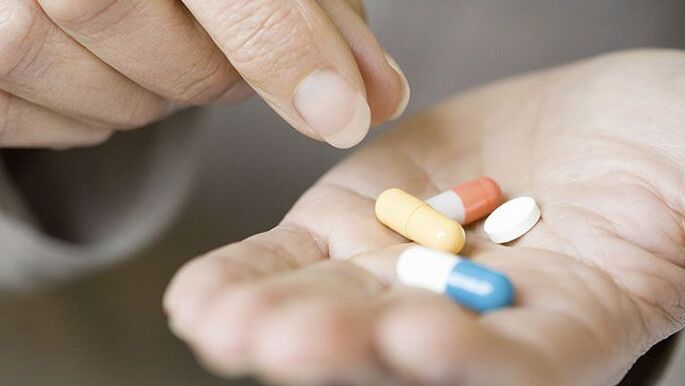
- NSAIDs. Since eliminating the inflammatory process and pain is the main task that causes discomfort in the knee area, doctors mainly recommend the use of non-steroidal anti-inflammatory drugs. For this purpose, they resort to the help of special pills and ointments. If the pain becomes severe, the patient is given an intramuscular injection. If your knee hurts a little, in this case, when asked: "What should I do? ", any doctor will advise you to use ointment. Typically, when the knee joint is injured, products containing glycosaminoglycan are used. In turn, to eliminate swelling, they resort to compresses with dimethyl sulfoxide;
- Chondroprotectors.Whether your knees hurt after running or long walks, or due to other medical conditions, only an experienced doctor can advise exactly what to do. However, the general recommendation for all patients to relieve pain is to take medications with chondroitin and glucosamine. Thanks to their use, it is possible to accelerate the restoration of cartilage tissue, prevent oxidative stress and ensure the development of healthy cartilage cells. In addition, chondroprotectors contribute to faster recovery times after injuries, minimize the likelihood of serious consequences and almost do not cause side effects. At the same time, experts recommend taking complexes with a high content of minerals and vitamins;
- Antispasmodics and vasodilators.They help improve tissue supply and help restore connective tissue and eliminate swelling. For example, when there are chronic medical processes, if your knee hurts all year, the discomfort returns and you don't know what to do, you may need additional antibacterial therapy and medication. immunogenic.
Physical therapy procedures
If you are wondering what to do if your knees hurt when walking or if the discomfort is chronic, any experienced specialist will recommend physical therapy treatment. . With its help, it is possible to increase the effectiveness of drug use, as well as ensure its delivery to deeper subcutaneous layers.
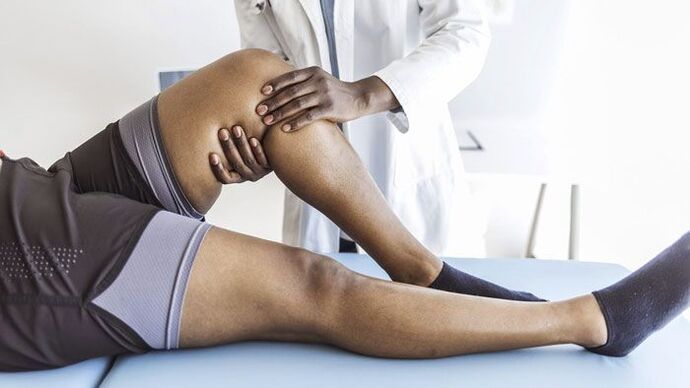
Physiotherapeutic procedures help improve blood flow, eliminate pain and reduce sources of inflammation, while normalizing motor activity and ensuring the removal of purulent secretions.
Even if your child's knees hurt and you're trying to figure out what to do, the following physical therapy methods will be most effective:
- Impact on the body of magnetic fields;
- Laser therapy;
- Exposure to electrical current associated with drug use;
- UHF;
- Application of galvanic current;
- Use healing mud;
- Therapeutic effects of ultrasound;
- Massage therapy;
- Paraffin therapy;
- Electroconvulsive therapy;
- Treatment with medicinal leeches;
- Acupuncture;
- Cold treatment;
- Diadynamic therapy and other similar procedures.
The duration of a course of physiotherapy usually reaches 7-10 procedures. However, the prerequisite before implementing treatment measures is to have consultation with a specialist.
UVT for knee pain
The UVT method is widely demanded in eliminating pathologies of the musculoskeletal system. It is based on short-term exposure to low-frequency sound waves on the affected joint.
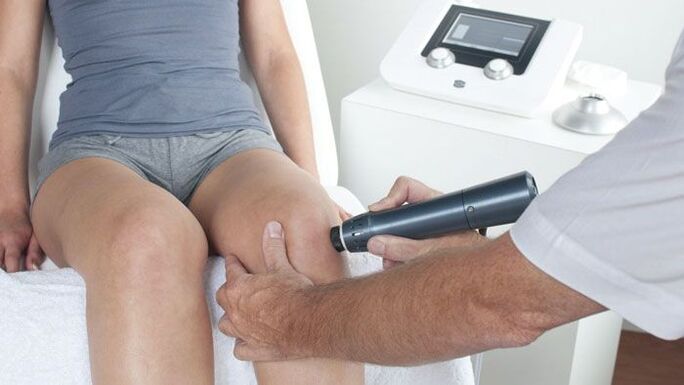
Powerful pain relief during shock wave therapy sessions is achieved through the following procedures:
- Improve blood flow;
- Development of new blood vessels;
- Improve metabolism.
It should be noted that under the influence of shock waves, a decrease in fibrotic processes in the tissues inside the knee joint is observed.
The greatest effect is achieved by using the UVT method to deposit calcium phosphate crystals in the tendon. This technique is characterized by increased safety and virtually no side effects.
UVT specialists will clearly determine the amount and duration of treatment, and also give valuable recommendations regarding the implementation of other restorative procedures.
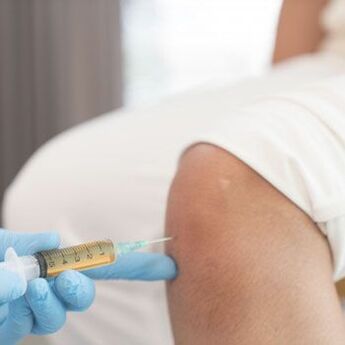
The need to make a puncture
If there is significant swelling, specialists will remove the pus that is limiting the normal function and supply of the joint. To drain the secretions, puncture is performed with a syringe under the influence of anesthesia.
If the desired results are not achieved during physical therapy and medication, the doctor will inject hyaluronic acid into the knee joint or perform anesthesia around the joint. When a purulent inflammatory process is detected, drug treatment is combined with the procedure of washing the knee joint with a medicinal solution (rinsing).
Surgical intervention to relieve pain in the knee area is performed in rare cases, usually in severe situations.
Exercise therapy for knee pain
Usually, when you have knee pain, experts recommend doing therapeutic exercises. By regularly performing simple exercises, the patient can quickly restore joint mobility, relieve pain and provide optimal load for this part of the body. These beneficial effects are achieved by improving muscle tone. You can get the desired results after 8-10 sessions. It is important to rule out any sudden movements during physical therapy.
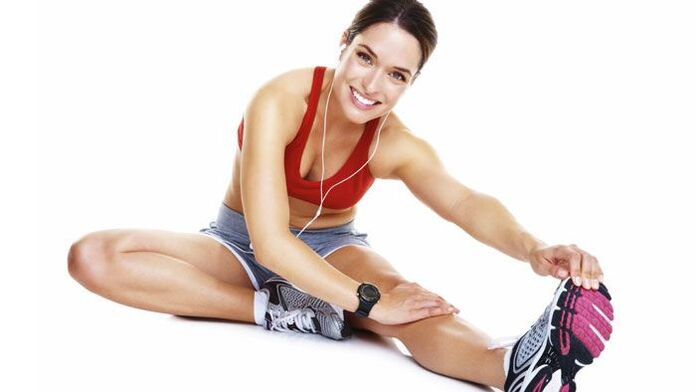
The following exercises are suitable to practice at home:
- The patient is in a "lying" position and stretches his legs forward. Next, he performs alternating flexion and extension of the fingers of the lower limb;
- Once in the "lying" position, you need to straighten your legs. Then the patient turns his legs in different directions, trying to bring them closer to the floor;
- In the "lying" position, legs are straightened, the patient tries to stretch the toes towards the knee joints;
- The patient is in a "lying" position. Then he placed both hands under his knees, trying to slowly bend the limb. In this case, the knees should be slightly raised towards the chest;
- While in the "lying" position, you need to perform the same foot movements as when riding a bicycle.
Preventive measures
Questions like: "What to do if the nerve in your knee hurts? ", or "What measures to take if your knee hurts after a long walk? " will no longer be relevant. if you follow simple precautions. Including:
- Elimination of infectious processes and conditions after knee injuries must be carried out under the supervision of a specialist;
- It is imperative to eliminate pathological processes of a chronic or hereditary nature (gout, diabetes, tonsillitis);
- Maintain a normal weight by eliminating overly sweet, salty and fatty foods, as well as alcoholic beverages from your diet;
- Engage in moderate exercise;
- Once a year, take chondroprotective medication and get examined by a specialist;
- Follow the rules of healthy sleep;
- Drink about 2-3 liters of still water per day;
- Eliminate any possibility of hypothermia;
- Wear only comfortable shoes and clothes;
- Avoid staying in one position for a long time.

















































